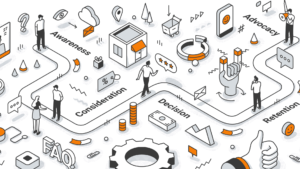Small to medium-sized businesses (SMBs) need a comprehensive marketing strategy to thrive in today’s competitive market.
A crucial component of this strategy is understanding the customer journey.
In this article, we’ll explain the customer journey and why it is a crucial piece of digital marketing. We’ll also explore how focusing on the customer journey can enhance brand awareness, increase conversion rates, boost customer retention, and ultimately drive business growth.
What is the Customer Journey?
The customer journey refers to a customer’s complete experience with a brand, from the initial awareness stage to the final purchase and beyond.
It encompasses every interaction a customer has with your business, whether online or offline. Understanding this journey helps companies to create targeted marketing strategies that resonate with their audience at each stage.
The Importance of the Customer Journey
The customer journey is crucial for several reasons:
- Enhanced Brand Awareness: By mapping out the customer journey, businesses can identify key touchpoints where potential customers interact with their brand. This allows for the creation of tailored content that captures attention and builds brand awareness.
- Improved Conversion Rates: Understanding the customer journey helps businesses identify and address pain points hindering conversions. By optimizing each stage of the journey, businesses can guide customers smoothly from awareness to purchase.
- Increased Customer Retention: A well-mapped customer journey enables businesses to nurture relationships with existing customers. Businesses can enhance loyalty and retention by providing ongoing value and addressing customer needs.
- Effective Marketing Strategy: A deep understanding of the customer journey informs the development of a robust marketing strategy. It helps businesses allocate resources effectively and tailor marketing efforts to meet the needs of their target audience.
Mapping the Customer Journey
Mapping the customer journey involves visualizing the steps customers take when interacting with your brand.
This process helps businesses understand the customer experience and identify opportunities for improvement.
A customer journey map typically includes the following stages, according to Adobe.
- Awareness: The customer becomes aware of a problem or need.
- Consideration: The customer researches potential solutions.
- Decision: The customer evaluates options and makes a purchase decision.
- Retention: The customer uses the product or service and receives support.
- Advocacy: The customer becomes a loyal advocate, promoting the brand to others.
Creating an Effective Customer Journey Map
To create an effective customer journey map, follow these steps:
- Define Your Buyer Personas: Understand who your customers are and what they need. Creating detailed buyer personas helps you tailor your marketing efforts to meet their specific needs.
- Identify Touchpoints: Determine where customers interact with your brand. This includes online channels like your website and social media, as well as offline interactions.
- Analyze Customer Needs and Pain Points: Identify the challenge customers face at each stage of the journey. Addressing these pain points can improve the overall customer experience.
- Optimize Each Stage: Develop strategies to enhance customer engagement at each touchpoint. This might include creating valuable content, providing excellent customer service, and offering personalized experiences.
The Role of Digital Marketing in the Customer Journey
Digital marketing plays a pivotal role in shaping the customer journey.
It encompasses a variety of tactics designed to engage customers at different stages. Here’s how digital marketing aligns with the customer journey.
Awareness Stage: Building Brand Awareness
At the awareness stage, the goal is to capture the attention of potential customers.
Digital marketing strategies such as search engine optimization (SEO), content marketing, and social media advertising are effective in increasing brand visibility. Providing informative and engaging content helps attract potential customers who are just beginning their journey, according to HubSpot.
Consideration Stage: Engaging Potential Customers
During the consideration stage, customers are actively seeking solutions.
Digital marketing efforts should focus on providing valuable information that helps them make informed decisions. Email marketing, webinars, and case studies are powerful tools for nurturing leads and building trust.
Decision Stage: Driving Conversions
At the decision stage, the focus shifts to converting prospects into customers.
Digital marketing tactics such as retargeting ads, personalized email campaigns, and customer testimonials can help drive conversions. Ensuring a seamless user experience on your website is also crucial for encouraging purchases.
Retention Stage: Enhancing Customer Loyalty
Retention is all about maintaining a positive relationship with your customers.
Digital marketing strategies like loyalty programs, personalized offers, and regular follow-up emails can enhance customer satisfaction and loyalty. Retaining existing customers is often more cost-effective than acquiring new ones, according to eMarketer.
Advocacy Stage: Turning Customers into Brand Advocates
The final stage of the customer journey involves turning satisfied customers into brand advocates.
Encourage customers to share their positive experiences through reviews and social media. Engaging with customers on social platforms and offering referral incentives can also foster brand advocacy.
Focusing on the Customer Journey in Your Digital Marketing
Optimizing the customer journey is essential for SMBs aiming to succeed in the digital age.
Focusing on the customer journey can help businesses enhance brand awareness, improve conversion rates, boost customer retention, and develop an effective marketing strategy.
By mapping out and optimizing your customer journey, you can create a seamless and engaging experience for your customers, ultimately leading to greater success in your digital marketing efforts.
If you’d like to learn more about how the customer journey fits into your digital marketing strategy, fill out the form below.






















